Water and Wastewater Treatment Technologies Market Size
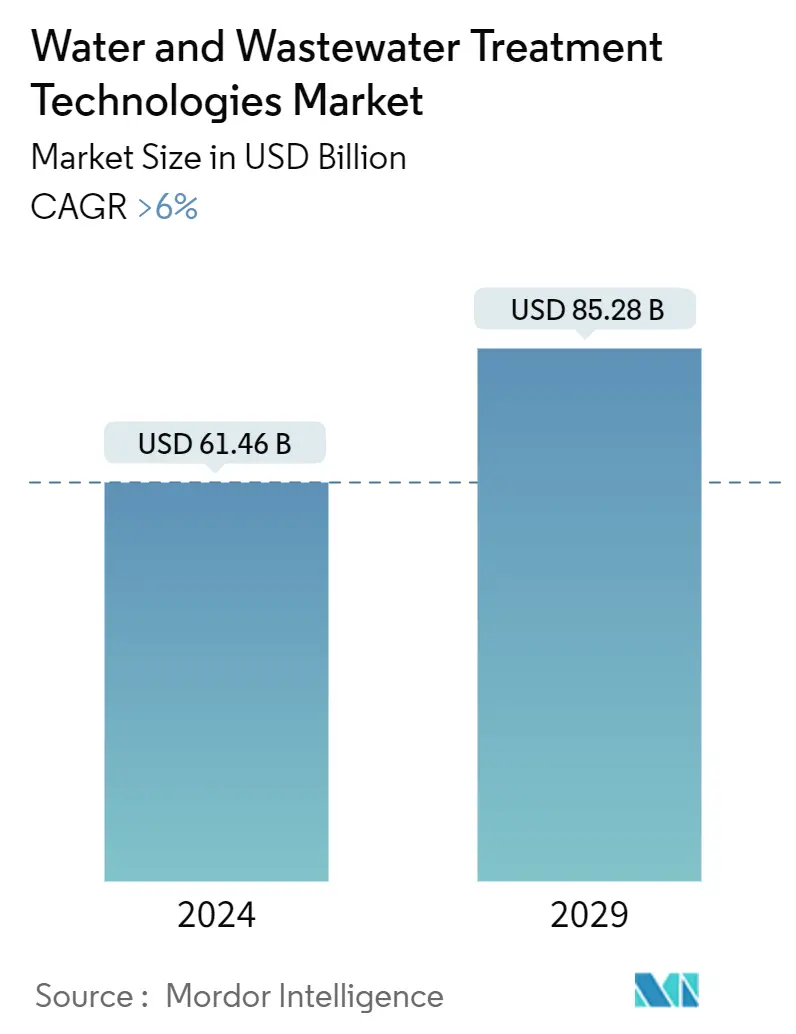
| Study Period | 2019 - 2029 |
| Market Size (2024) | USD 61.46 Billion |
| Market Size (2029) | USD 85.28 Billion |
| CAGR (2024 - 2029) | 6.00 % |
| Fastest Growing Market | Asia Pacific |
| Largest Market | Asia Pacific |
Major Players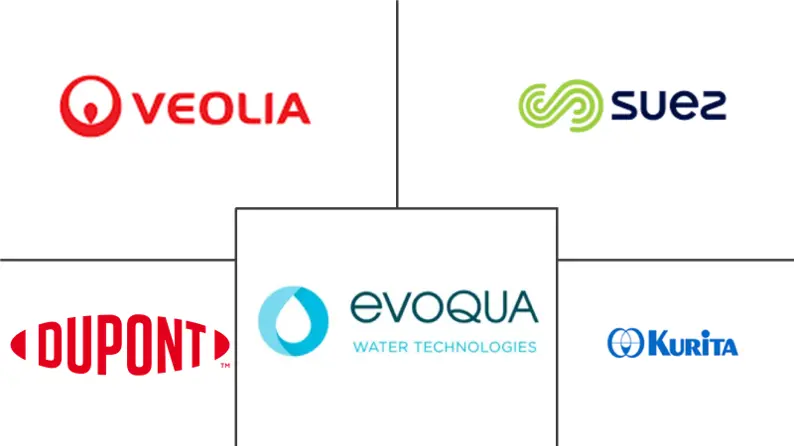
*Disclaimer: Major Players sorted in no particular order |
Water and Wastewater Treatment Technologies Market Analysis
The Water And Wastewater Treatment Technologies Market size is estimated at USD 61.46 billion in 2024, and is expected to reach USD 85.28 billion by 2029, growing at a CAGR of greater than 6% during the forecast period (2024-2029).
The COVID-19 pandemic negatively impacted the market. It was because of the shutdown of the manufacturing facilities and plants due to the lockdown and restrictions. Supply chain and transportation disruptions further created hindrances for the market. However, the industry witnessed a recovery in 2021, thus rebounding the demand for the market studied.
- Over the short term, rapidly diminishing freshwater resources worldwide, increasing demand from shale gas exploration activities, and growing wastewater complexities in developing economies are some factors driving the market's growth studied.
- On the flip side, the high cost of water treatment plants is expected to hinder the studied market's growth.
- However, innovations in water treatment technologies are anticipated to act as an opportunity for the market studied.
- Asia-Pacific is likely to witness the highest growth rate during the forecast period.
Water and Wastewater Treatment Technologies Market Trends
Municipal Water and Wastewater Treatment Segment is Expected to Dominate the Market
- Municipal wastewater is the water draining from toilets, showers, sinks, bathrooms, washing machines, dishwashers, and liquid industrial waste. Municipal wastewater should be treated before releasing it into the environment to avoid damage to the environment and the spreading of harmful diseases.
- The major applications of treatment technologies include preliminary treatment, primary and secondary treatment, tertiary treatment, biological nutrient removal (BNR), resource recovery, energy generation, and others.
- There are nearly 1,944 municipal wastewater treatment plants across China's city/urban regions and 1,599 municipal wastewater treatment plants across China's counties. It accounts for daily processing capacities of 140 and 29 million cubic meters, respectively. In the 14th five-year plan (FYP), China published new guidelines for wastewater reuse. It mandated raising the proportion of sewage that must be treated to reuse standards to 25% by 2025.
- Due to various government initiatives, water purification is expected to increase significantly during the forecast period. With the 2030 Water Resources Group, the Council on Energy, Environment, and Water (CEEW) plans to improve wastewater management in India and increase private investments in water treatment chemicals manufacturing companies to build wastewater treatment facilities and raw materials.
- Furthermore, Stormwater Treatment Area 1 West Expansion project involves the construction of water treatment facilities on 2,509ha of land in Florida, the United States, with an investment of USD 170 million.
- Wastewater technology is primarily used in municipal wastewater treatment by the municipal authority of various cities across India. According to the World Bank, India, China, Indonesia, Nigeria, and the United States will lead the world's urban population surge by 2050.
- Moreover, the municipal water treatment in various municipalities in the country is observing a significant increase owing to government initiatives to provide the more rural population access to safe and adequate drinking water within their premises.
- According to the Ministry of Jal Shakti of the Government of India, in FY 2022, the percentage of the rural population with access to safe and adequate drinking water within premises increased to 61.52% from 55.23% in FY2021. Furthermore, the Indian government aims to provide 100% of its population safe and adequate drinking water within premises by 2024 or 2025. It will boost the municipal water treatment plants in the country.
- IDE Technologies, an Israeli firm, joined hands with the government of Andhra Pradesh to set up desalination plants in various states to overcome the water scarcity in the cities.
- To fulfill water scarcity, the Council on Energy, Environment, and Water (CEEW), in association with the 2030 Water Resources Group, is planning to improve wastewater management in India and increase private investments in building wastewater treatment plants.
- Over the past few years, the urban sewage capacity in India grew significantly. This growing capacity will likely drive the country's innovative water treatment technology demand.
- Hence, owing to the abovementioned factors, municipal water, and wastewater treatment technologies will likely dominate the market during the forecast period.
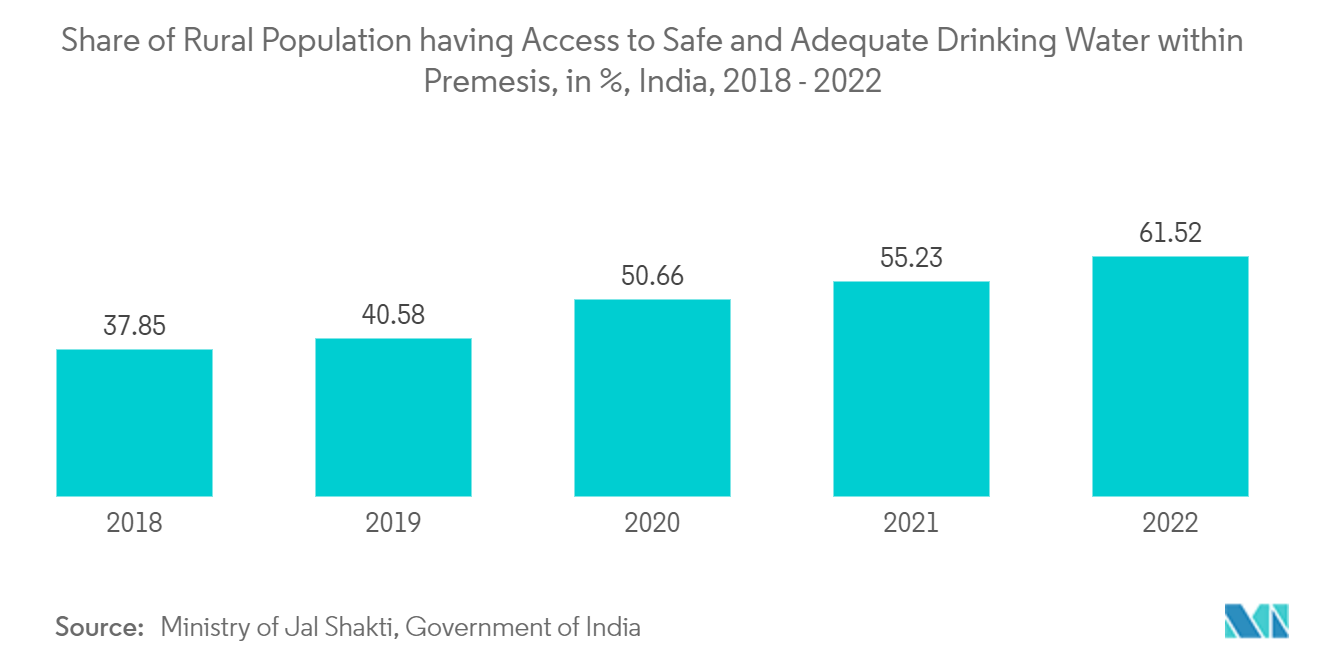
Asia-Pacific is Likely to Dominate the Market
- Asia-Pacific accounted for the major share of the water and wastewater treatment technologies market due to high demand from countries like China, India, and Japan.
- China is discharging more wastewater than industrial wastewater in recent times. Adding to the issue is the huge pollution problem, especially in the major industrial locations of the country. Currently, 80% of sludge in China is improperly dumped, an increasingly controversial environmental issue with urban centers scrambling to decrease pollution by improving their wastewater treatment plants (WWTPs). Therefore, it is expected to create an upside demand for the country's water and wastewater treatment technologies market.
- Chemical manufacturing applications account for a considerable share of the total freshwater withdrawal. Furthermore, increasing scarcity of fresh water and various environmental initiatives are anticipated to boost recycling and water reuse from municipal waste.
- For instance, in June 2022, China Everbright Water, an environmental protection company that focuses on water environment management, secured the expansion and upgrading project of the ZhangdianEast Chemical Industry Park Industrial Wastewater Treatment in Zibo City, Shandong Province. This project will be operated on a BOT (Build-Operate-Transfer) model, with a designed daily industrial wastewater treatment capacity of around 5,000 m3.
- China also announced the construction of 20 million m3/d of additional wastewater treatment capacity over the next 5 years.
- Moreover, according to International Trade Administration, China plans to build or renovate 80,000 km of sewage collection pipeline networks and increase sewage treatment capacity by 20 million cubic meters/day between 2021 and 2025. Therefore, creating an upside demand for the water and wastewater treatment technologies market.
- The sewage penetration rate in Japan is ~76%, with the country generating more than 2.2 million tons of sewage sludge on a dry basis. Sewage sludge contains 60-80% organic matter and constitutes a stable energy source.
- Furthermore, the Japanese food processing industry produces a wide range of foods, from traditional to processed food, for infants and older people. The food processing industry in the country is estimated to grow in the coming years, owing to the higher consumption of food and beverage products. The rising demand for packaged food is driving the food and beverage industry in the country. For instance, in March 2022, Domino's Japan opened its 900th store. It is the first Domino's Pizza Enterprises Ltd market to reach the milestone nine months after opening the Company's 800th store. Therefore, the expansion of the food and beverage industry in the country is expected to create an upside demand for the water and wastewater treatment technologies market in the country.
- Based on the above factors, Asia-Pacific is expected to dominate the global water and wastewater treatment technologies market during the forecast period.
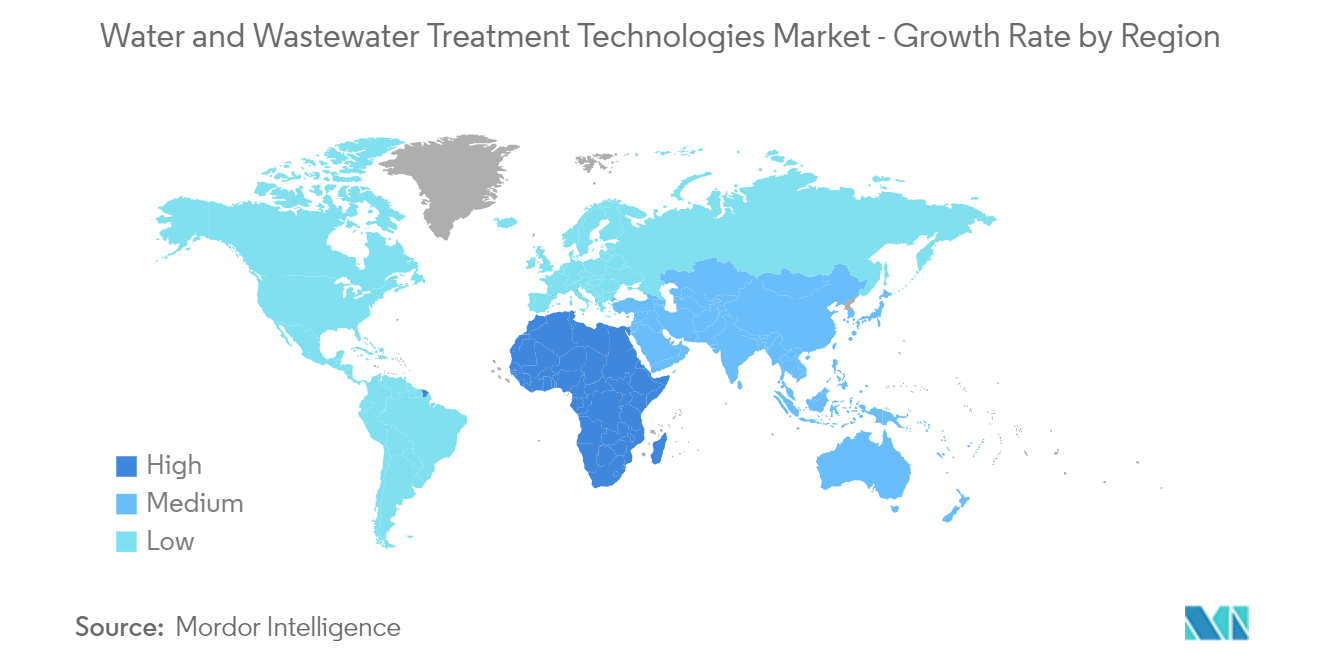
Water and Wastewater Treatment Technologies Industry Overview
The Water and Wastewater Treatment Technologies Market is partially fragmented in nature. The major players in this market (not in any particular order) include Veolia, SUEZ, Evoqua Water Technologies LLC, DuPont, and Kurita Water Industries Ltd., among others.
Water and Wastewater Treatment Technologies Market Leaders
-
Veolia
-
Evoqua Water Technologies LLC
-
DuPont
-
Kurita Water Industries Ltd.
-
SUEZ
*Disclaimer: Major Players sorted in no particular order
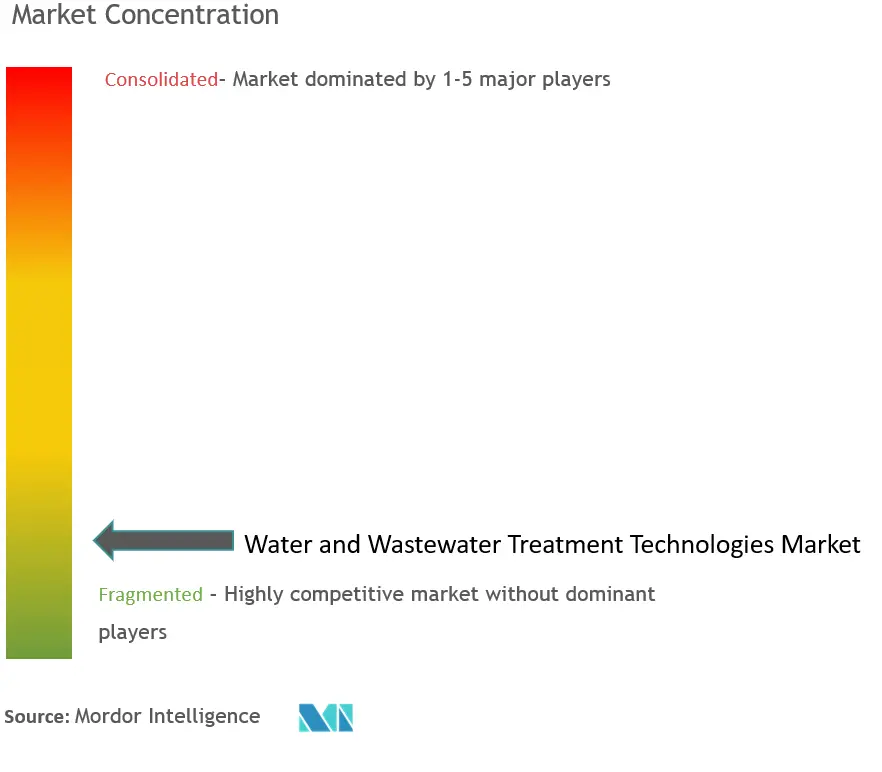
Water and Wastewater Treatment Technologies Market News
- February 2023: Solenis completed the acquisition of the stock of the Grand Invest Group. Solenis will acquire all Grand Invest Group operating assets, including key strategic production and warehousing facilities. It will expand its Latin American water treatment portfolio.
- November 2022: WABAG LIMITED signed an agreement with the Asian Development Bank ('ADB') for raising a fund of INR 200 crores (~ USD 24.6 million) through unlisted Non-Convertible Debentures carrying five years and three months tenors. ADB will subscribe to it over 12 months for its water treatment business.
- August 2022: Veolia Environment SA's former United Kingdom-based waste-treatment company will be acquired by French utility Suez SA for about EUR 2.3 billion (USD 2.42 billion). Suez is now ready to take back the UK assets, which were also put up for sale after the country's competition authority objected.
- May 2022: Veolia announced the acquisition of Perth-based company Allpipe Technologies. The deal saw Veolia Water expand its network services activities to different areas of Western Australia, strengthening its position in water solutions.
Water and Wastewater Treatment Technologies Market Report - Table of Contents
1. INTRODUCTION
- 1.1 Study Assumptions
- 1.2 Scope of the Study
2. RESEARCH METHODOLOGY
3. EXECUTIVE SUMMARY
4. MARKET DYNAMICS
-
4.1 Drivers
- 4.1.1 Rapidly Diminishing Freshwater Resources
- 4.1.2 Increasing Demand from Shale Gas Exploration Activities
- 4.1.3 Growing Wastewater Complexities in Developing Economies
-
4.2 Restraints
- 4.2.1 High Cost of Water Treatment Technology
- 4.2.2 Lack of Awareness on Appropriate Usage of Water Treatment Techniques
- 4.3 Industry Value Chain Analysis
-
4.4 Porter's Five Forces Analysis
- 4.4.1 Bargaining Power of Suppliers
- 4.4.2 Bargaining Power of Buyers
- 4.4.3 Threat of New Entrants
- 4.4.4 Threat of Substitute Products and Services
- 4.4.5 Degree of Competition
5. MARKET SEGMENTATION (Market Size in Value)
-
5.1 Type
- 5.1.1 Oil/Water Separation
- 5.1.2 Suspended Solids Removal
- 5.1.3 Dissolved Solids Removal
- 5.1.4 Biological Treatment/Nutrient and Metals Recovery
- 5.1.5 Disinfection/Oxidation
- 5.1.6 Other Types
-
5.2 End-user Industry
- 5.2.1 Municipal Water and Wastewater Treatment
- 5.2.2 Food and Beverage
- 5.2.3 Pulp and Paper
- 5.2.4 Oil and Gas
- 5.2.5 Healthcare
- 5.2.6 Poultry and Aquaculture
- 5.2.7 Chemical and Petrochemical
- 5.2.8 Other End-user Industries
-
5.3 Geography
- 5.3.1 Asia-Pacific
- 5.3.1.1 China
- 5.3.1.2 India
- 5.3.1.3 Japan
- 5.3.1.4 South Korea
- 5.3.1.5 ASEAN Countries
- 5.3.1.6 Rest of Asia-Pacific
- 5.3.2 North America
- 5.3.2.1 United States
- 5.3.2.2 Canada
- 5.3.2.3 Mexico
- 5.3.3 Europe
- 5.3.3.1 Germany
- 5.3.3.2 France
- 5.3.3.3 United Kingdom
- 5.3.3.4 Italy
- 5.3.3.5 Rest of Europe
- 5.3.4 South America
- 5.3.4.1 Brazil
- 5.3.4.2 Argentina
- 5.3.4.3 Rest of South America
- 5.3.5 Middle-East and Africa
- 5.3.5.1 Saudi Arabia
- 5.3.5.2 South Africa
- 5.3.5.3 Rest of Middle-East and Africa
6. COMPETITIVE LANDSCAPE
- 6.1 Mergers and Acquisitions, Joint Ventures, Collaborations, and Agreements
- 6.2 Market Share(%)**/Ranking Analysis
- 6.3 Strategies Adopted by Leading Players
-
6.4 Company Profiles
- 6.4.1 AECOM
- 6.4.2 Aquatech International LLC
- 6.4.3 Black and Veatch Holding Company
- 6.4.4 Doosan Heavy Industries and Construction
- 6.4.5 DuPont
- 6.4.6 Ecolab
- 6.4.7 Evoqua Water Technologies LLC
- 6.4.8 Hindustan Dorr-Oliver Ltd
- 6.4.9 Hitachi, Ltd.
- 6.4.10 ITT INC.
- 6.4.11 Kurita Water Industries Ltd
- 6.4.12 Mott MacDonald
- 6.4.13 REMONDIS SE and Co. KG
- 6.4.14 SLB
- 6.4.15 Siemens
- 6.4.16 SUEZ
- 6.4.17 Thermax Limited
- 6.4.18 VA Tech Wabag Ltd.
- 6.4.19 Veolia
- *List Not Exhaustive
7. MARKET OPPORTUNITIES AND FUTURE TRENDS
- 7.1 Innovations in Water Treatment Technologies
- 7.2 Shifting Focus Toward Green Chemicals
Water and Wastewater Treatment Technologies Industry Segmentation
Water and wastewater treatment technologies are processes to remove contaminants from wastewater or sewage from various industries, commercial buildings, and others and convert them into effluents that can be released into the environment with reduced harmful impact. The market is segmented based on type, end-user industry, and geography. The market is segmented by type into oil/water separation, suspended solids removal, dissolved solids removal, biological treatment/nutrient and metals recovery, disinfection/oxidation, and other types. By end-user industry, the market is segmented into municipal water and wastewater treatment, food and beverage, pulp and paper, oil and gas, healthcare, chemical and petrochemical, and other end-user industries. The report offers market size and forecasts for 15 countries across major regions. For each segment, market sizing and forecasts are based on revenue (USD) for all the above segments.
| Type | Oil/Water Separation | |
| Suspended Solids Removal | ||
| Dissolved Solids Removal | ||
| Biological Treatment/Nutrient and Metals Recovery | ||
| Disinfection/Oxidation | ||
| Other Types | ||
| End-user Industry | Municipal Water and Wastewater Treatment | |
| Food and Beverage | ||
| Pulp and Paper | ||
| Oil and Gas | ||
| Healthcare | ||
| Poultry and Aquaculture | ||
| Chemical and Petrochemical | ||
| Other End-user Industries | ||
| Geography | Asia-Pacific | China |
| India | ||
| Japan | ||
| South Korea | ||
| ASEAN Countries | ||
| Rest of Asia-Pacific | ||
| Geography | North America | United States |
| Canada | ||
| Mexico | ||
| Geography | Europe | Germany |
| France | ||
| United Kingdom | ||
| Italy | ||
| Rest of Europe | ||
| Geography | South America | Brazil |
| Argentina | ||
| Rest of South America | ||
| Geography | Middle-East and Africa | Saudi Arabia |
| South Africa | ||
| Rest of Middle-East and Africa |
Water and Wastewater Treatment Technologies Market Research FAQs
How big is the Water And Wastewater Treatment Technologies Market?
The Water And Wastewater Treatment Technologies Market size is expected to reach USD 61.46 billion in 2024 and grow at a CAGR of greater than 6% to reach USD 85.28 billion by 2029.
What is the current Water And Wastewater Treatment Technologies Market size?
In 2024, the Water And Wastewater Treatment Technologies Market size is expected to reach USD 61.46 billion.
Who are the key players in Water And Wastewater Treatment Technologies Market?
Veolia, Evoqua Water Technologies LLC, DuPont, Kurita Water Industries Ltd. and SUEZ are the major companies operating in the Water And Wastewater Treatment Technologies Market.
Which is the fastest growing region in Water And Wastewater Treatment Technologies Market?
Asia Pacific is estimated to grow at the highest CAGR over the forecast period (2024-2029).
Which region has the biggest share in Water And Wastewater Treatment Technologies Market?
In 2024, the Asia Pacific accounts for the largest market share in Water And Wastewater Treatment Technologies Market.
What are the emerging trends in the Water and Wastewater Treatment Market?
The emerging trends in the Water and Wastewater Treatment Market are a) Increasing adoption of smart water treatment systems with IoT technology b) Focus on the affordability of water treatment solutions c) Growing popularity of point-of-use water treatment systems d) Rising demand for desalination technologies
Water and Wastewater Treatment Technologies Industry Report
The global water and wastewater treatment market is experiencing significant growth, driven by the increasing demand for clean water resources across various sectors, including municipal, agricultural, and industrial processes. The market size is segmented into chemicals, equipment, and services, with the services segment holding the largest share due to the focus on upgrading and maintaining treatment plants. The chemicals segment is dominated by coagulants and flocculants, essential for sludge treatment, while the equipment segment sees substantial investments in filtration and disinfection technologies. The municipal segment leads the market, driven by high water treatment demand in agriculture and urban areas, while the industrial segment is expected to grow due to tightening regulations.
The adoption of smart water treatment technologies, including IoT-enabled systems, is on the rise, enhancing the efficiency and reliability of water infrastructure. The market analysis indicates that the water treatment industry outlook remains positive, with ongoing advancements and investments expected to drive further growth and innovation in the sector. Industry reports and market research highlight the market trends and market growth, emphasizing the importance of market leaders in driving the market forecast and industry overview.
Industry analysis provides insight into market segmentation and market value, while industry information and market data offer a comprehensive market overview. The market report and market review suggest that market predictions and market outlook are optimistic, supported by industry statistics and industry trends. Research companies have provided a detailed industry research, including a report example and report pdf, which underline the importance of market segmentation and market value in understanding the market dynamics.
Overall, the industry sales and industry size are expected to increase, driven by the growth rate and market growth observed in recent years. The market forecast and market predictions indicate a positive trajectory for the water and wastewater treatment market, with significant contributions from market leaders. The market outlook and market overview suggest that the industry is poised for substantial growth, supported by industry research and industry trends. The report example and report pdf provide a detailed analysis of the market segmentation and market value, highlighting the key drivers and challenges in the market.



